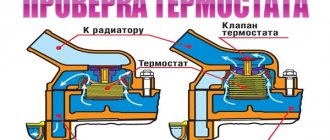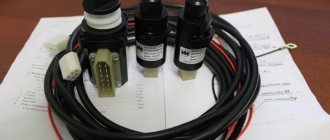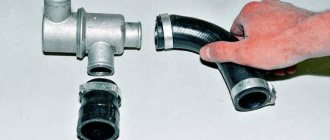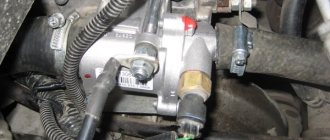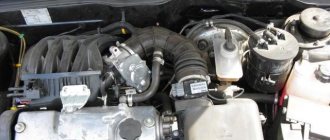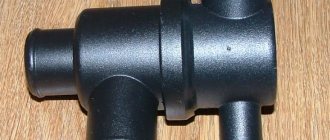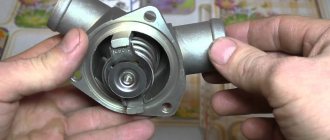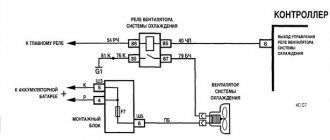Let's check the functionality of the thermostat of the carburetor engine cooling system of VAZ 2105, 2107, 2108, 2109, 21099 cars. To check the thermostat and evaluate the correctness of its operation, you need to know its role in the car's cooling system and the principle of operation.
The thermostat separates two circles of the cooling system (small and large) and has two valves: bypass and main. While the engine is warming up, coolant circulates through the small circle and the open thermostat bypass valve. The thermostat prevents it from mixing with the liquid from the large circle and thereby helps the engine warm up quickly. Therefore, the simplest way to check the functionality of the thermostat is by touch, directly on the car. When operating correctly, its upper part warms up first, and then the lower part.
The procedure for checking the thermostat on VAZ 2108, 2109, 21099 cars without removing it from the engine
When the engine warms up, circulation occurs in a small circle. Warms up: cylinder block, cylinder head, carburetor heating block, stove, upper part of the thermostat. We check the heating of the thermostat with our hands: its upper part should be warm, and after a few minutes it becomes hot. The bottom of the thermostat remains cold. In addition, the lower hose to the radiator will also be cold, and the upper one will be slightly heated.
After some time, the lower part of the thermostat and the lower radiator hose suddenly become hot - this opens the main thermostat valve. Circulation went through the radiator (large circle).
The procedure for checking the thermostat on VAZ 2105, 2107 cars without removing it from the engine
The check is similar to the check on VAZ 2108, 2109, 21099, only when circulating in a small circle, the following elements of the cooling system warm up: the cylinder head tee, the upper hose to the radiator, the upper radiator tank, the heater. The lower part of the radiator and its lower hose remain cold. After the thermostat operates at a temperature of 80-85º (the coolant temperature gauge needle is 3-4 mm from the red zone), the lower part of the thermostat and the lower radiator tank warm up.
Checking the removed thermostat
You can check the removed thermostat of VAZ 2105, 2107, 2108, 2109, 21099 cars. To do this, immerse it in a container with hot water (preheating temperature 73-75º). We heat the water further, stirring it, and observe the movement of the main thermostat valve. When the valve begins to open (approximately 1 mm), the temperature of the liquid should be measured. If the thermostat is working, it will be 81±5º for VAZ 2105, 2107 and 87±2º for VAZ 2108, 2109, 21099. A faulty thermostat should be replaced.
Notes and additions
— The stroke of the main thermostat valve at 102º for VAZ 2108, 2109, 21099 is about 8 mm. For VAZ 2105, 2107 at 94º from 6 to 8 mm.
More articles on VAZ car engines
If the thermostat fails, the engine will take a very long time to heat up to the required operating temperature, and while driving, the engine temperature will drop sharply. This is especially felt in winter due to a poorly heating stove.
Appearance of the device
Self-replacement of the VAZ-2109 thermostat
How to check and replace the VAZ-2109 thermostat (8 or 16 valves)?
This procedure is not very complicated, and even a less experienced car owner can handle it without much difficulty. What needs to be done is described in this article. The thermostat itself is a mechanical device whose operation is based on purely physical principles. Inside it is wax that is sensitive to temperature changes. When the coolant heats up, the substance melts and, as a result, the damper opens, allowing it to enter the cooling system. From the VAZ-2109 to the relatively new Granta, thermostats work exactly the same, and moreover, they are interchangeable. True, the new units are somewhat shorter than the old ones, but this in no way prevents them from being installed.
Often, from the above-mentioned more modern model, a thermostat is installed if the stove does not “fry” too much.
see also
“Peter - AT” INN 780703320484 OGRNIP 313784720500453
What is a VAZ-2109 thermostat, when is it necessary to replace it, what are the main signs of failure, we will tell you in this article. Our publication also contains a detailed description of how to install a more advanced thermostat from a model 2110 car. Its advantages will be discussed a little below. And it’s worth starting with theory; you need to understand what kind of device the thermostat has, what functions it performs in the cooling system of an internal combustion engine.
How is the check carried out?
First of all, it is worth pointing out that on a VAZ-2109 (with an 8-valve engine, as well as a 16-valve engine) you do not need to drain the coolant to check. The procedure is:
- start the engine;
- check the temperature of the lower pipe leaving the radiator.
Normally, it should remain cold, since the liquid circulates only in a small circuit. It heats up gradually. As the coolant reaches a temperature ranging from 87 to 92 degrees and the wax in the thermostat melts, the damper opens and a large circle begins to operate. If this does not happen, then the thermostat will have to be changed.
Before buying a new one, check whether the old one is really damaged. This is not difficult to do, just put the device in a pan of water (on a rag) and heat it to 87-90 degrees. A working device will open the main valve.
How to check the thermostat without removing it from the car
The thermostat is a key component of the cooling system, which is responsible for high-quality warming up of the engine by timely redirecting coolant flows in a small or large circle. Failure of this component inevitably leads to a number of problems - overheating of the engine or the inability of it to reach the desired temperature.
That's why a car enthusiast needs to know how to check the thermostat and what malfunctions of this device exist.
Common reasons for device failure
During the operation of the car, the following thermostat breakdowns and the reasons for their occurrence are possible.
1. Increased heating time of the power unit.
The motor operates unstably (for example, it trips), which leads to excessive fluctuations of the thermostat valve and damage to its seat. Due to exposure to strong vibration, damage to the temperature-sensitive element occurs.
The result is that coolant gets inside the unit (wax comes out), which leads to a malfunction of the device, which stops opening or closing the valve when the required temperature level is reached.
2. The valve of the device opens ahead of time. The cause of such a breakdown may be the ingress of coolant into a special element that controls the temperature level of antifreeze in the system.
The result is an increase in the total volume of the filler and premature opening of the valve.
3. The thermostat opens with a delay.
The reason is the appearance of a leak of a special filler that allows the device to respond to temperature changes.
Changing the volume of this element downwards will require more heating to open the valve.
The result is that the thermostat operates with a certain time delay.
4. The engine regularly overheats.
For example, situations are possible when the thermostat allows coolant to pass through on time, but the engine still reaches a high temperature.
The reason is that the fluid is not passing through the main radiator, but is being discharged through the return line back into the engine.
5. The thermostat valve is not fully open due to mechanical damage.
The result is a small volume of liquid entering the radiator to completely reduce the temperature in the system.
6. The valve is not fully closed.
This is possible when coolant “sneaks” into the working element.
Due to the increase in the volume of the working element, the valve disc cannot close completely.
7. Incorrect operation of the device.
For example, opening and closing it ahead of time. This is possible in case of failures in the factory settings and excessive overheating of the cooling system of the power unit.
8. Destruction of the rubber seal.
Due to a breakdown, oil gets into the coolant. The latter acts as a solvent for the rubber valve seal (rubber simply cannot withstand the impact).
3
Ways to solve problems Possible solutions to the problem include:
1. If the coolant temperature exceeds the norm (provided the thermostat is working and it is correctly selected), it is necessary to replace the device, but with a higher opening temperature. As a rule, this step is recommended for motorists who operate cars in the mountains and in regions with high average annual temperatures.
2. When opening the thermostat late, it is important to ensure that there are no plugs and that the system is completely filled. If the problem is caused by a plug (coolant stagnation), then the best solution is to make a small hole in the plate (2-3 mm). As a result, the coolant flow near the thermostat is normalized, and the engine warm-up time increases.
3. Early opening of the thermostat is possible due to excessive pressure in the system. Zones of different pressure often appear around the device, which leads to early operation of the valve.
There are several reasons:
- failure of the cooling system;
- The thermostat spring has weakened;
- The engine runs at higher speeds during the warm-up period.
4. The engine takes too long to warm up.
Causes:
- incomplete closing of the thermostat valve;
- violation of the integrity of the valve plate (for example, a gap has appeared);
- Incorrect thermostat position (possibly changing the location of the air valve).
5. The engine heats up above normal even in a situation where the thermostat is fully open:
- traffic jams or low coolant level;
- failure of the radiator (clogging of its cells);
- failure of the cooling pump or fan;
- contamination of the cooling system.
How the thermostat works in a car
Brass and copper are the main components from which these devices are made. And the basic principle of operation of a car thermostat is hidden by a small cylinder that can be seen from the engine side. The cylinder contains a small wax ball, although not made from real wax; the melting point of the material from which it is made is 82 degrees Celsius. Wax was not chosen as a material for this element by chance; it has the property of increasing in volume under the influence of temperature, that is, making transitions from solid to liquid. When the wax melts and expands, it will create pressure that will cause the pin to fall out of the cylinder and open the valve through which coolant enters the radiator. And when the engine temperature returns to normal, the wax hardens again, taking its previous position and shape.
There are many factors that can cause problems, but corrosion is the most common. When the valve is constantly in the open position, engine cooling fluid will always flow into the radiator before entering the engine, which means the engine needs more time to reach critical temperature. And when the thermostat valve is constantly closed, the engine does not cool down and continues to gain temperature, accordingly, the car “boils” and you cannot continue driving it until the engine cools down. Experts and auto mechanics recommend that motorists replace the old one with a new one approximately every two years. Read how to change the thermostat in a VAZ 2110-2111 car.
Thermostat diagram VAZ 2107, 2114, 2115
How to correctly determine that the device is in working condition?
We warm up the engine to such a temperature that the needle does not reach the critical value, and turn it off. We open the hood, find a hose on top of the radiator (a black rubber hose with a metal clamp at the end) and the same one on the bottom. Then, very carefully, they may be quite hot, touch them. If one of them becomes hot, and the other is still cold, and the sensor shows a high engine temperature, this means that most likely the liquid does not enter the engine, but is retained in the radiator, and you need to change the thermostat to a new one.
There is another way of checking, better known as “folk”. It echoes the “experiment” that was described above, to observe the process of the thermostat, only this time you will have to put the thermostat, the functionality of which you doubt, removed from your car, into a container with water, and then the procedure is repeated as Once the water reaches a temperature of 87–90 degrees, the valve should open, however, if this does not happen, then the thermostat is no longer suitable for operation. It is also worth remembering that different thermostats may have different critical valve opening temperatures, so when purchasing a new one, check this with the seller. Since it is no secret to the driver that it is impossible to install a thermostat in a car that has a high valve opening temperature - the engine will not cool.
Dismantling
If it becomes necessary to remove the thermostat, then it will not be possible to do without draining the coolant. Some craftsmen claim that they were able to avoid the above procedure, but in reality it turns out that this option requires much more labor and still leads to the loss of 3 out of 5 liters of liquid. Therefore, it is better not to suffer and do everything as it should be. To do this, unscrew the plug located at the bottom of the radiator and drain the coolant into a suitable container. Then:
- remove the air filter;
- loosen the clamps holding the hoses;
- disconnect the mass from the thermostat;
- Unscrew the nut and pin holding the device.
Coolant drain
Removing the thermostat is not difficult. The only difficulty is that you need to drain the coolant. If the engine protection is installed, this will become quite difficult.
Draining fluid from a carburetor engine is very simple. To do this, we will use a carburetor heating unit:
- Unscrew the cap of the expansion tank.
- Loosen the pipe clamp.
- Remove the end of the hose.
- Drain the coolant into a container no smaller than 4 liters, otherwise it may not fit into the small volume.
This method is not suitable for an injector. On such an engine, you can remove the hose from the radiator and drain the liquid. This can also be done with a carburetor engine, but this method involves draining a larger volume of liquid.
After this procedure, the coolant level will be below the thermostat. After this, the unit can be easily replaced with a working one.
Installing a New Thermostat
Before installing a working device, it is necessary to clean its location from dirt and rust. Apply a thin, even layer of any neutral sealant to the degreased surface. You should wait at least 10 minutes for it to dry slightly. After this, a new node is installed.
In the end, all that remains is to pour the required amount of coolant into the system, making sure that no air pockets form.
To make sure that everything is functioning normally, you need to start the power plant and inspect all connections for leaks. If detected, the latter are eliminated by tightening the fastening clamps.
No. 2 thermostat WEEN Poland
ween
Great thermostat! He kept the temperature accurately. Neither in winter nor in summer, nor in any traffic jams, did the valve turn on. Worked for 1 year. And one hot summer day I noticed. Temp. 103 degrees, and this is on the highway. The valve is working. I set the stove to full heat and somehow got there.
Result: jammed in a small circle. The manufacturer did not comply with the 2 years or 150,000 thousand km warranty it declared. Accordingly, WEEN went after the “factory one.” although it’s a shame, the thermos was good.
Thermostat of the VAZ-2109 car
The legendary Soviet and Russian car VAZ-2109 has a number of shortcomings. One of which is the thermostat. The VAZ-2109 thermostat is a carburetor type and is not dismountable; the same model, but smaller in size, is also installed on injection engines of this model. The article provides information about the design, operating principle, testing and replacement of the VAZ-2109 thermostat.
Is it possible to install a thermostat 2110 on “nine”?
This question was partly answered in the previous paragraph. Yes, you can install a VAZ-2110 thermostat on a 2109, and it doesn’t matter at all whether the “nine” is carburetor or injection. In fact, starting from the “eight”, the engines are used the same. What can we say, even modern “Grants” are equipped with an engine that has been used on “eights” and “nines” since the 80s. Progress, to say the least. Of course, instead of a carburetor there is now a more modern injection system, which by European standards was outdated 5-10 years ago. And almost all components are interchangeable. There are minor differences and improvements, but this does not change the overall picture.
Design and operating principle
The VAZ-2109 thermostat is a metal or bronze flask with four pipes and a valve inside. This model is two valve. It is located under the hood, on the left side of the engine. The upper pipe connects to the engine, the middle one to the pump, the lower one, of large diameter, to the radiator. The thinnest pipe is connected by a long narrow hose to the expansion barrel.
This node works according to the following principle:
- After the engine starts, the liquid circulates in a narrow circle, since the thermostat only opens the intake valve.
- When the temperature reaches 87 degrees, the inlet valve closes and the main valve opens.
- The liquid begins to circulate throughout the complete system, along with the radiator.
Thus, the thermostat is one of the main parts of engine cooling.
Signs of breakdown
What could be the first sign that the VAZ-2109 thermostat is faulty? Of course, the engine overheats even when driving at a high constant speed. The reason is that the liquid continues to circulate in a small circle, not a drop gets into the radiator. And even turning on the electric fan won’t help, because doing so is simply useless. The only thing that can slightly correct the situation is opening the heater tap and turning on the interior airflow at maximum speed.
But such an action will not bring comfort in hot weather. The most common thermostat breakdown is the sensing element jamming in its original position (the liquid moves in a small circle). If this suddenly happens, then you need to try all methods of elimination. Even a few light blows to the body can open the valve. If such an emergency occurs on the road, you will have to drain the liquid and break all the insides of the thermostat so that the liquid circulates only in a large circle. But it won’t boil, and you can get to the repair site.
Malfunctions
A faulty thermostat can cause poor warm-up or overheating of the engine. The reasons are as follows:
- Insufficient or prolonged heating causes the main valve to open until the antifreeze reaches a temperature of 80–90 degrees. The reason lies in the formation of scale in the seat or in the loss of valve spring stiffness.
- Overheating occurs due to the fact that the main valve does not open, the antifreeze boils because there is no interaction with the liquid from the radiator. The reason is that the main valve is stuck in the seat. This often occurs after the car has been idle for a long time.
No. 4 BAUTLER BTL0008T China 215 rub.
bautler
Sometimes it happens that Chinese spare parts are better than domestic ones. But the miracle did not happen. This one turned out to be complete x. and g...m. Above 85 gr. t of the engine never rose when driving. Only in traffic jams did it reach 91 degrees. Result: Either it’s a defect, or it’s set up for a complete opening. I don't recommend it.
Although if you put it on in the summer and take it off for the winter, then that’s it. Summer option so to speak. In my case, winter was approaching, and it was decided to send him after the others.
Examination
There are 2 ways to check the VAZ-2109 thermostat. The first can be done without removing the part from its installation site. To do this you need:
- Start the engine and monitor its heating using the sensor on the dashboard.
- Once it reaches 80–90 degrees, check the lower radiator hose.
- If the pipe is hot, the thermostat is in working order, if not, then it needs to be replaced.
The second method of checking involves removing the part from the car. Next you need:
- Place the part in a container of water.
- Place the container on the stove and let it heat up.
- Use a thermometer to monitor the temperature rise.
- When it reaches 87–90 degrees, the valve should open.
- Afterwards, you need to remove the part and let it cool.
- The valve should close after cooling.
If opening or closing does not occur, the part must be replaced.
Refilling the cooling system
It will take you a few minutes to add fluid and bleed the cooling system. First of all, check that all pipes are securely installed and that all clamps are tightened. Then look to see if the engine block and radiator plugs are in place. If not, then install them. Now you can open the stove tap and pour liquid into the expansion tank. The gurgling stopped - they closed the plug and started the engine. Wait until it warms up to operating temperature - about 90 degrees. If necessary, add fluid to the reservoir. It is necessary that its level is between the lower and upper marks.
Replacement
Replacing the VAZ-2109 thermostat is very simple. To do this you need:
- Allow the engine to cool completely.
- Drain the antifreeze through the drain window at the bottom of the radiator.
- Using a screwdriver, loosen all 4 clamps holding the pipes.
- Remove the thermostat.
- Install the new part by securing all 4 clamps and adding coolant to the radiator.
After adding fluid, you must start the engine without closing the cap of the expansion tank. This will allow all the air to leave the cooling system.
No. 5 thermostat PRAMO with Polish thermoelement Russia, Vladimir 300 rub.
pramovlad
I use it to this day, the flight is normal. Regulates temperature well. Even in traffic jams and in courtyards, the ventel is silent, only after a whole day of driving it occasionally reminds itself of itself. The engine warms up quite quickly. Bottom line: Good thermostat, for the money. I recommend.
I'm adding
The PRAMO thermostat bent at the end of winter. After the positive feedback, it started not working so well. Probably jinxed it. What was it? In winter, it warmed for a long time, and when the temperature reached operating temperature, I kept the fan at the limit of turning on the fan. But in the end it jammed into a small circle. Plus it was still leaking along the flaring. Bottom line: don’t take X and G!
How did these thermostats get me, maybe I’m the only one unlucky?
Scheme and design
In order to promptly determine the malfunction, check or replace the thermostat, you must first understand its circuit and design elements.
The scheme presented above is deciphered as follows.
Item number
| 1. | Inlet pipe coming from the radiator |
| 2. | Rubber insert |
| 3. | Heat sensitive solid filler |
| 4. | Bypass valve spring |
| 5. | Inlet pipe coming from the engine |
| 6. | Bypass valve |
| 7. | Outlet pipe going to the pump |
| 8. | Main valve spring |
| 9. | Main valve |
| 10. | Pipe coming from the expansion tank |
| 11. | Piston |
Reasons to install a thermostat from “ten”
The 6-hole unit has been modified, when compared with the device installed in the “nine”, its advantages over the 5-hole version from 2109 are as follows:
- The device from the “ten” is 5 cm shorter than the standard version of the “nine”, so there will be more space under the hood.
- A more modern 6-hole thermostat works more stably, as a result, the temperature remains unchanged.
- In the event of a breakdown, you do not have to change the entire device, since it is dismountable, and if necessary, you can only change the thermoelement.
- When servicing, you won’t have to struggle with a large number of clamps, since the 6-hole version is secured with a rubber tube.
- It should be noted that until 2003, VAZ 2110s were also equipped with a device with five holes, so you need to buy a version from later releases.
